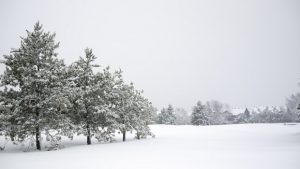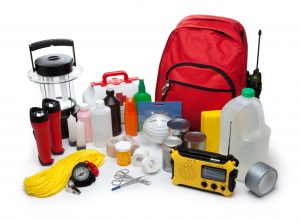When extreme winter weather storm warnings are issued for an area, property damage and disruptions to daily life are possible. It is vitally important to prepare your home to withstand harsh weather conditions and have a safety plan in place in case of emergency. Check out these 5 tips to safeguard and protect your home this winter.
Springlike warmth in December 2020 forced winter weather advisories in parts of the Northeast, when rapid snowmelt posed the risk of flooding. Fortunately for the Lehigh Valley, the clashing of seasonal weather wrapped up fairly quietly resulting in heavy snowfall and wind gusts, but in other parts of Pennsylvania strong winds, flooding rains and severe weather posed dangerous risks. Taking time for necessary preparations will go a long way to protect your home and family from severe winter weather conditions.
1. Test Smoke and Carbon Monoxide Detectors
Make a habit of regularly testing your home smoke and carbon monoxide detectors monthly and replacing batteries every six months. Simply press the test button and after a second or two a loud siren or alert should sound. Carbon Monoxide detectors are especially important during winter months when heaters and home fireplaces are often in use. The National Safety Council reports fireplaces, gas ranges, furnaces, grills, small engines, stoves and portable generators can emit carbon monoxide in the home, a hazardous gas often undetected by smell, that can be life threatening in large quantities.
2. Review Roof Conditions
 Damaging wind gusts, ice dams, hail and strong thunderstorms often cause exterior damage and water leaks. According to the National Severe Storms Laboratory, high winds are likely to cause damage once they reach or exceed 50 mph. In Lehigh Valley, straight-line winds reached 45 mph as recently as November 2020, uprooting trees, downing power lines and damaging roofs. At that wind speed, home exteriors can be vulnerable. Excessive roof snow can also lead to dangerous conditions. Ice dams can accumulate around the roof line, causing leaks when built up ice and heavy snow accumulation begin to melt. To prevent future damage, safely use a roof rake to remove excess snow and break up ice dams following each snow storm. Seal chimneys and vent pipes to prevent water leaks inside the home and consider a professional contractor review of the structural integrity of the roof or damaged roof shingles and gutters in the event of visible or suspected roof damage. Also take the time to clear debris from clogged gutters and downspouts to prevent the possibility of flooding or water damage to the home’s structure and foundation.
Damaging wind gusts, ice dams, hail and strong thunderstorms often cause exterior damage and water leaks. According to the National Severe Storms Laboratory, high winds are likely to cause damage once they reach or exceed 50 mph. In Lehigh Valley, straight-line winds reached 45 mph as recently as November 2020, uprooting trees, downing power lines and damaging roofs. At that wind speed, home exteriors can be vulnerable. Excessive roof snow can also lead to dangerous conditions. Ice dams can accumulate around the roof line, causing leaks when built up ice and heavy snow accumulation begin to melt. To prevent future damage, safely use a roof rake to remove excess snow and break up ice dams following each snow storm. Seal chimneys and vent pipes to prevent water leaks inside the home and consider a professional contractor review of the structural integrity of the roof or damaged roof shingles and gutters in the event of visible or suspected roof damage. Also take the time to clear debris from clogged gutters and downspouts to prevent the possibility of flooding or water damage to the home’s structure and foundation.
3. Weatherproof Windows and Doors
Weatherproofing frames around windows and doors will prevent warm air from escaping the home and keep water from leaking in. If not properly maintained, small gaps or cracks in flashing or weather stripping can soak the interior of the home, causing rot and corrosion. Window and door frames weakened by winter storm weather conditions can leak water inside the home, causing mold growth and damage to interior walls and finishes. Prevent the threat of water entering the home by replacing worn weather strips and fixing damaged areas surrounding windows and door frames with caulking.
4. Care for and Maintain Trees
 Tree branches hanging heavy with snow and ice are at risk to break. Large tree limbs positioned close to the home, or hanging over parked vehicles or outdoor decks can be especially dangerous and pose a threat for property damage. Before limb cracks or breaking sets in, gently clear branches after heavy snowfall. The Arbor Day Foundation recommends gently pushing branches up from below with an extension pole or broom, carefully whisking away snow while watching for any falling branches. If branches are covered in ice, allow it to melt naturally. Keeping trees healthy with proper pruning by a professional arborist prior to seasonal snowfall will create strong, healthy and structurally sound trees that can successfully weather a winter storm.
Tree branches hanging heavy with snow and ice are at risk to break. Large tree limbs positioned close to the home, or hanging over parked vehicles or outdoor decks can be especially dangerous and pose a threat for property damage. Before limb cracks or breaking sets in, gently clear branches after heavy snowfall. The Arbor Day Foundation recommends gently pushing branches up from below with an extension pole or broom, carefully whisking away snow while watching for any falling branches. If branches are covered in ice, allow it to melt naturally. Keeping trees healthy with proper pruning by a professional arborist prior to seasonal snowfall will create strong, healthy and structurally sound trees that can successfully weather a winter storm.
5. Assemble a Winter Storm Readiness Kit
 An emergency supply kit is a vital part of emergency preparedness. The Family Handyman offers tips for making DIY storm readiness kits with items including flashlights, batteries, blankets and board games to keep everyone busy, placed in a plastic container with a tight-fitting lid or a waterproof duffel bag in an area accessible and known to all family members. Check out their how-to guide for preparing your own storm readiness kit. Also consider having an emergency supply kit stocked with essential items in your vehicle and workplace. The Commonwealth of Pennsylvania provides an emergency supply kit item checklist for home, vehicle and workplace emergency preparedness. Cold weather accessories including coats, boots, hats, gloves and scarfs should also be stored in plain sight in entryway baskets or hooks for quick grab and go in case of emergency.
An emergency supply kit is a vital part of emergency preparedness. The Family Handyman offers tips for making DIY storm readiness kits with items including flashlights, batteries, blankets and board games to keep everyone busy, placed in a plastic container with a tight-fitting lid or a waterproof duffel bag in an area accessible and known to all family members. Check out their how-to guide for preparing your own storm readiness kit. Also consider having an emergency supply kit stocked with essential items in your vehicle and workplace. The Commonwealth of Pennsylvania provides an emergency supply kit item checklist for home, vehicle and workplace emergency preparedness. Cold weather accessories including coats, boots, hats, gloves and scarfs should also be stored in plain sight in entryway baskets or hooks for quick grab and go in case of emergency.
At Signature Homes by JT Maloney, we pride ourselves in being a trusted home construction company building quality Lehigh Valley homes. We understand how important it is to keep your home protected during severe weather. Contact us via email or call (610) 849-3759 today to begin planning and designing the home of your dreams.



